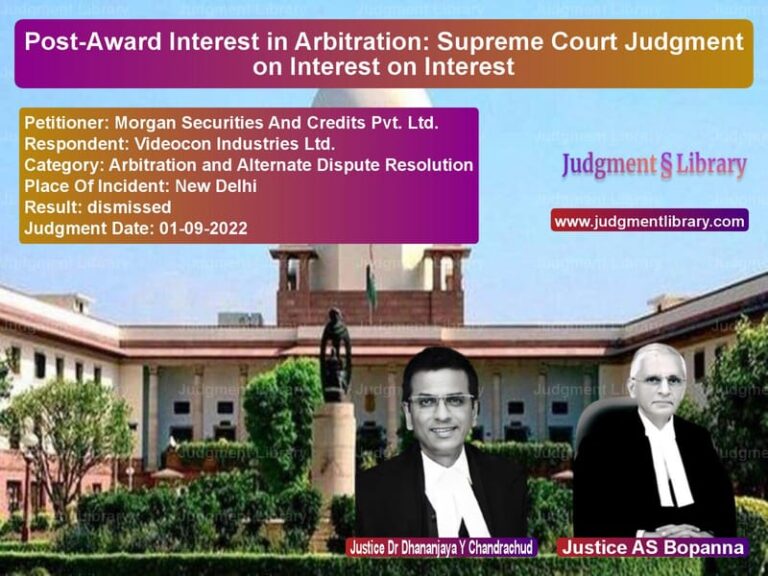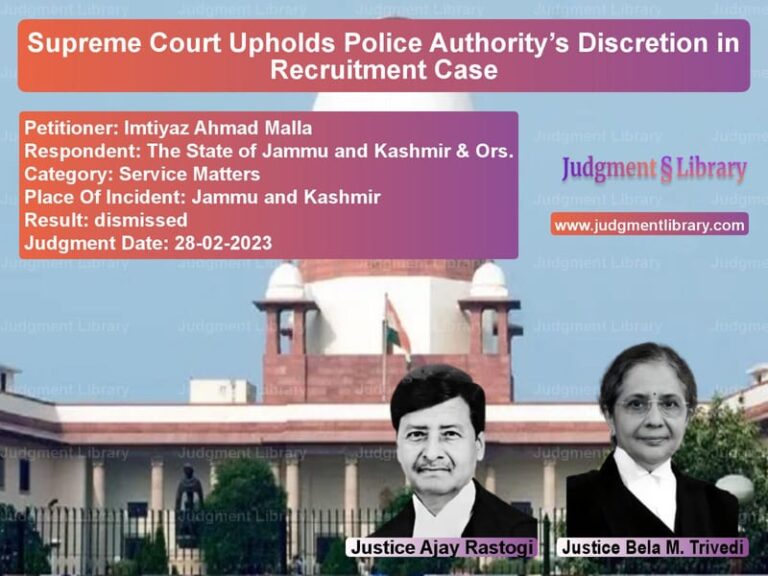Supreme Court Rules on Village Common Land Dispute in Haryana
The case of Patram v. Gram Panchayat Katwar & Ors. revolves around the question of whether a specific piece of land in Haryana falls within the definition of ‘shamilat deh’ under the Punjab Village Common Lands (Regulation) Act, 1961. The Supreme Court had to determine whether the land in the appellant’s possession for over a century could be classified as common village land and whether it rightfully vested with the Gram Panchayat.
The appellant, Patram, argued that the land was not being used for common purposes and had always been in the possession of his ancestors. The Gram Panchayat, however, claimed that it was part of the village common lands and should be governed under the 1961 Act. The Supreme Court ruled in favor of the appellant, holding that the land did not qualify as ‘shamilat deh’ and should not be vested with the Gram Panchayat.
Background of the Case
The dispute arose over land located in Katwar village, Haryana. The appellant had been cultivating the land for over a hundred years, and the revenue records reflected his family’s possession. However, the Gram Panchayat contended that the land was classified as ‘shamilat deh’ and was meant for the benefit of the entire village community.
Under the Punjab Village Common Lands (Regulation) Act, 1961, lands reserved for village common purposes are deemed to be under the control of the Gram Panchayat. The key legal question in this case was whether the land occupied by the appellant fell under this category.
Key Legal Issues
- Whether the land was classified as ‘shamilat deh’ under Section 2(g) of the Punjab Village Common Lands (Regulation) Act, 1961.
- Whether the land had ever been used for common village purposes.
- Whether the revenue records supported the claim of the appellant’s exclusive possession.
- Whether the High Court erred in concluding that the land vested with the Gram Panchayat.
Arguments by the Appellant (Patram)
The appellant contended that:
- The land had been in possession of his family for over a hundred years and had never been used for common village purposes.
- The revenue records consistently showed the land as ‘Shamlat Patti Dhera & Khubi,’ indicating family ownership rather than village common land.
- The Punjab Village Common Lands (Regulation) Act, 1961, only applies to land used for common village purposes, which was not the case here.
- The Gram Panchayat’s claim was based on a misinterpretation of revenue entries.
Arguments by the Respondents (Gram Panchayat Katwar & Ors.)
The Gram Panchayat countered that:
- The land was recorded as ‘shamilat deh’ and thus belonged to the village community.
- The classification in the revenue records did not negate the fact that the land was subject to common usage laws.
- The land was an integral part of the village commons, and allowing individual ownership would set a precedent against village land conservation.
- The High Court correctly ruled in favor of the Gram Panchayat based on statutory interpretation.
Supreme Court’s Observations
The Supreme Court analyzed the historical and legal context of village common lands in Haryana and made the following observations:
- ‘Shamilat deh’ lands are those reserved for common village purposes, such as grazing and community activities.
- The land in question had been continuously cultivated by the appellant’s family and was not designated for village community use.
- The revenue records did not indicate that the land had ever been assigned for common village purposes.
- The High Court erred in concluding that the land automatically vested in the Gram Panchayat.
The Court further noted:
“The absence of clear documentation proving that the land was used for common purposes means that it cannot be arbitrarily classified as ‘shamilat deh.’ The appellant’s long-standing possession, coupled with revenue records, supports his claim.”
Final Judgment
The Supreme Court allowed the appeal and ruled that:
- The land in dispute did not fall within the definition of ‘shamilat deh’ under the Punjab Village Common Lands (Regulation) Act, 1961.
- The High Court’s order vesting the land in the Gram Panchayat was set aside.
- The name of the appellant should be restored in the ownership records.
- The judgment of the High Court was quashed, and all previous administrative orders regarding the land were nullified.
Conclusion
This judgment underscores the importance of clear documentation and long-standing possession in land disputes. Key takeaways from the ruling include:
- Village common land laws should not be applied arbitrarily.
- Historical possession and revenue records play a crucial role in land disputes.
- The state cannot assume ownership without proving common usage.
The ruling reaffirms the principle that ownership claims must be based on clear evidence rather than presumptions about village common lands.
Petitioner Name: Patram.Respondent Name: Gram Panchayat Katwar & Ors..Judgment By: Justice Deepak Gupta, Justice L. Nageswara Rao.Place Of Incident: Haryana.Judgment Date: 04-03-2020.
Don’t miss out on the full details! Download the complete judgment in PDF format below and gain valuable insights instantly!
Download Judgment: Patram vs Gram Panchayat Katwa Supreme Court of India Judgment Dated 04-03-2020.pdf
Direct Downlaod Judgment: Direct downlaod this Judgment
See all petitions in Property Disputes
See all petitions in Landlord-Tenant Disputes
See all petitions in Specific Performance
See all petitions in Judgment by Deepak Gupta
See all petitions in Judgment by L. Nageswara Rao
See all petitions in allowed
See all petitions in Quashed
See all petitions in supreme court of India judgments March 2020
See all petitions in 2020 judgments
See all posts in Civil Cases Category
See all allowed petitions in Civil Cases Category
See all Dismissed petitions in Civil Cases Category
See all partially allowed petitions in Civil Cases Category







